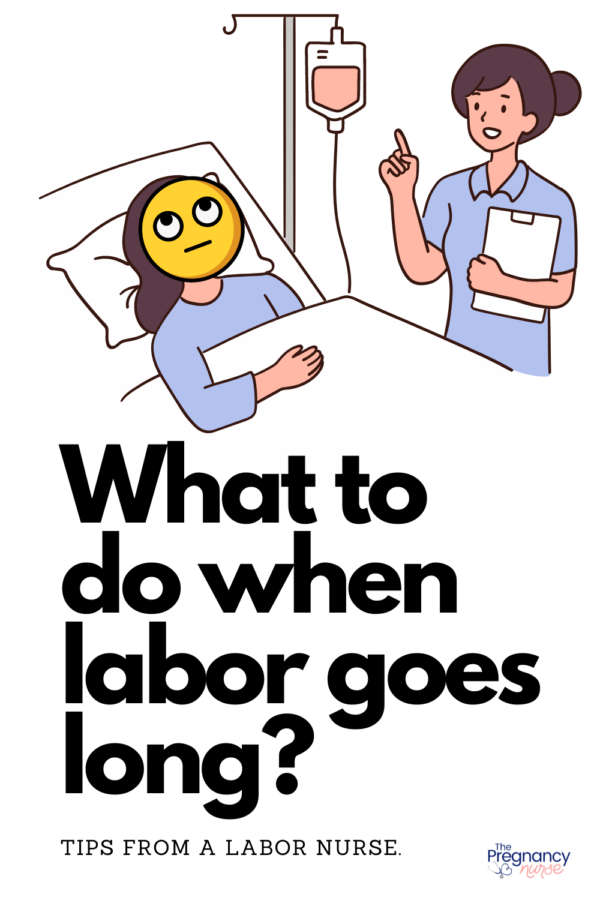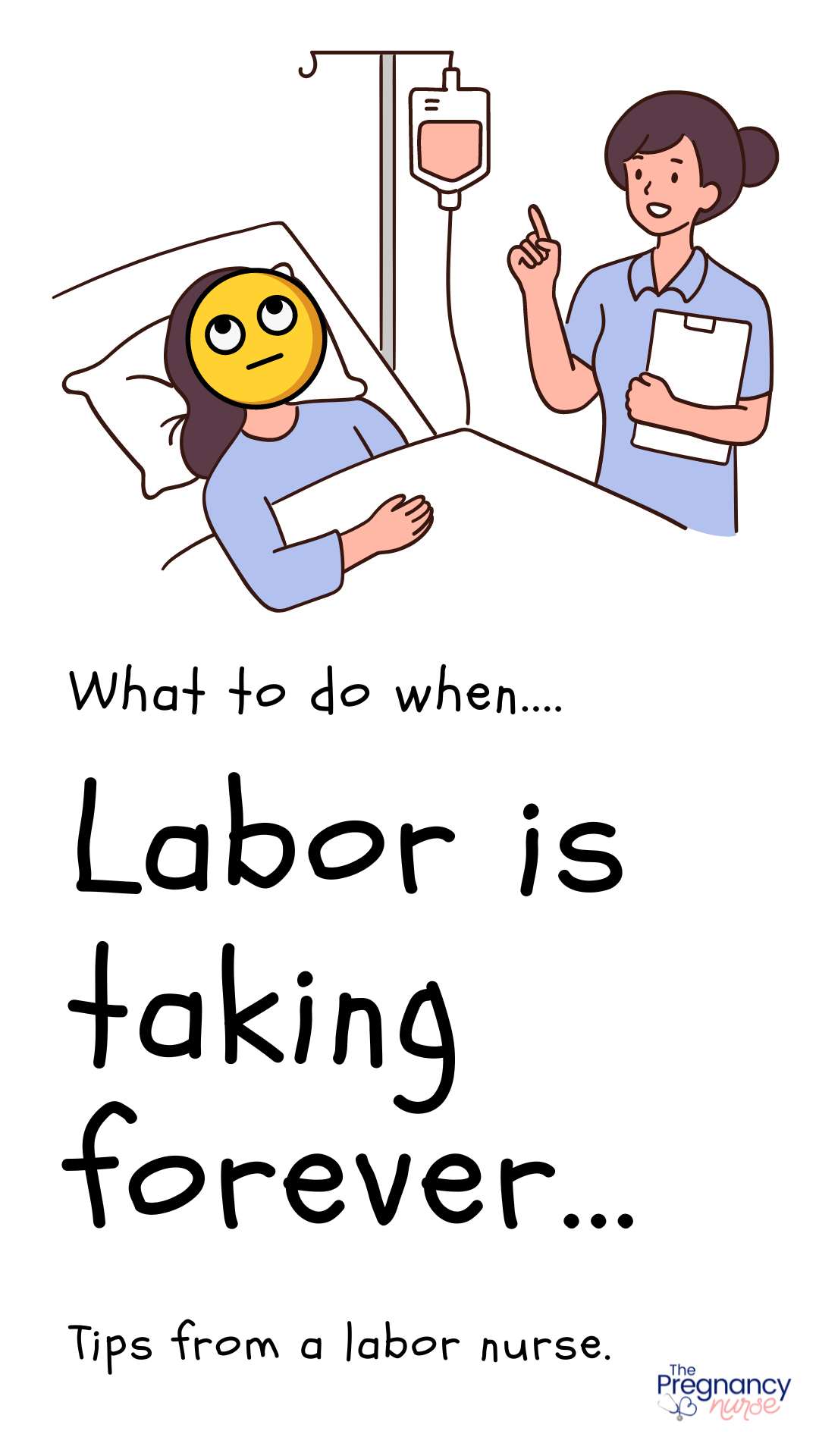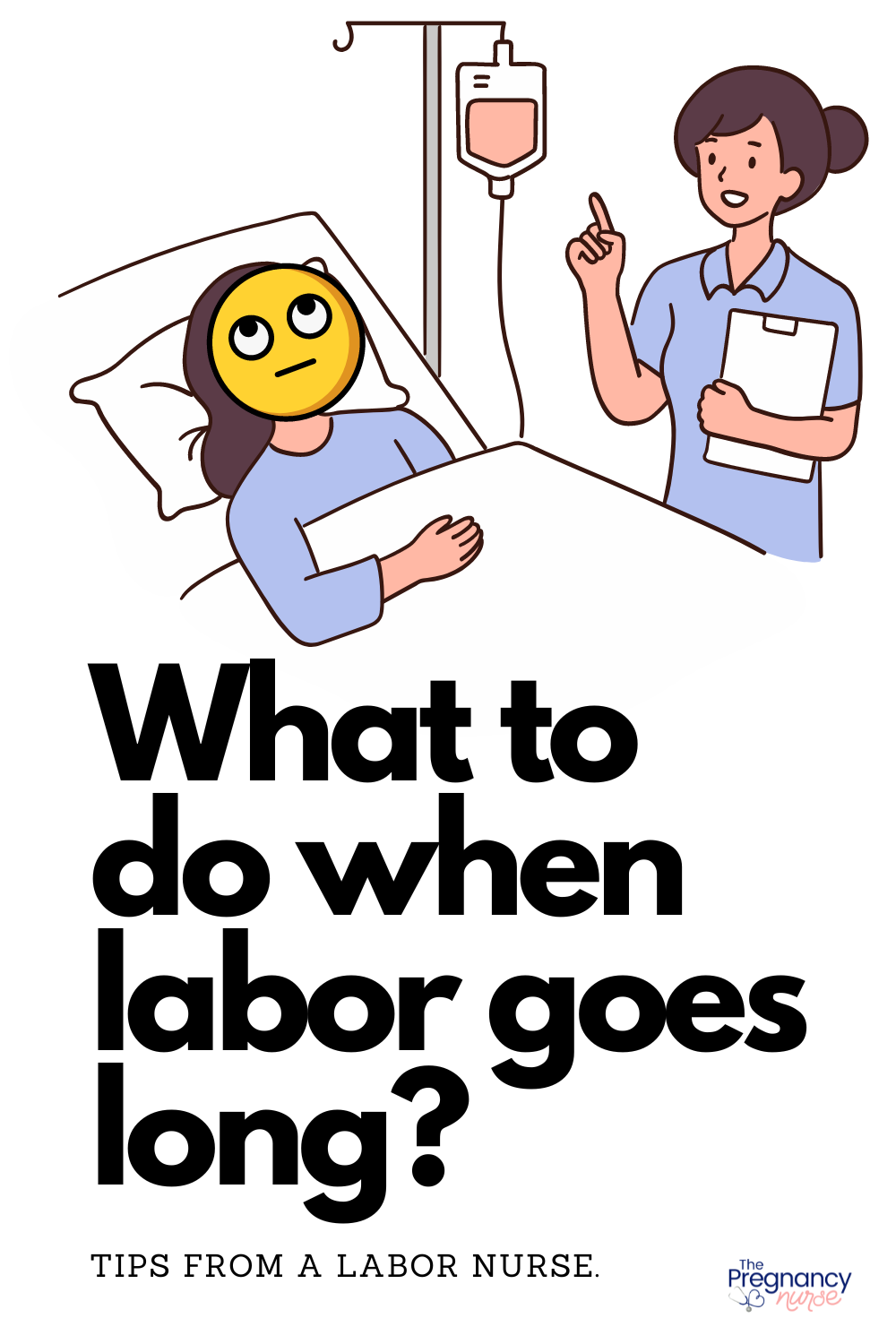👋 I’m so glad YOU are here. Are you looking to also get your partner prepared? This is for BOTH of you. Couples just love it and I know you want to both feel prepared!
You’re in labor, but it’s just not progressing like you’d hoped (or possibly how the staff wished it would). What are some things you can do to speed it up?
Before we get going it’s SO important to have realistic expectations of your labor. If you’re going by what friends told you, or what you’ve seen on TV or on birth stories online you’re going to be woefully mis-informed. I recommend this to get your expectations aligned with reality. 🙂
Did you know that unmet expectations (and often unrealistic ones of ourselves and others) are one of the biggest causes of birth trauma? When I say it’s important to have realistic expectations, I’m not kidding.

Move
I was reading a book with an old-timey midwife in it. She was always taught that when labor wasn’t progressing to MOVE. I couldn’t agree more!
Now, unfortunately some patients, hospitals and providers have a hard time getting along with this one.
Patients really like to just try to get rest in bed (especially if they have an epidural)
Hospitals like patients on their back because it’s easier to “do the things” in that case.
Providers don’t love moving patients who are unwilling to help move — we can (and have) hurt ourselves trying to do too much.
So, what can YOU do to help make this happen?
Tell your providers you want to promote movement — if they know you want to move they’re much more likely to come-up with ideas and positions to move to. Stay tuned because we are going to talk more about how to do this!
Get your partner in on the action — partners LOVE something to do in the very boring hospital. However, they sometimes need a nudge to get “in there”. Telling them to help move you will both make it easier for the nurses to move you and help them feel involved (it really isn’t brain surgery, anyone can help reposition patients).
Labor at Home — this ship may have sailed for some of you, but I would guess that many of you guys are reading this before birth. I can’t encourage you ANY more to labor at home as long as you can. It’s WAY easier to move at home before you get the monitors on. If you’re at the hospital, you could figure out if intermittent auscultation is an option for you.
Often at the hospital if you’re not “quite” into active labor they’ll give you the option to go home for a bit. Unless you’re desperate for medical pain management, more time at home can often be SO much more comfortable and can help movement. A lot of people feel like a “failure” if they go home, but you have to make the best choice for YOU! FYI… I went home once, slept some and then came in much more in active labor).
Honestly, I think that promoting movement is one of the BEST things you can put on your birth plan. Not sure what ELSE to put on it — get my tips here:
Now, movement is going to vary depending on if you have an epidural or not…. let’s discuss both (because you don’t know which type of birth you’ll have).
Movement Without an Epidural
This is your chance to stand up now and then.
I can be tempting to stay in bed to try to sleep or rest between contractions, but if you’re not sleeping — MOVE. Some of your movements can be similar to those with the epidural below — but I am a huge fan of:
- Getting on all fours (helps with back labor especially) — do yoga’s cat to cow to stretch out tired back muscles. You can also do this on the bed to cushion your knees
- Lunges — seriously, I’ve seen some assisted lunges (either standing by the bed, using the rail in the hallway or a steady partner) do wonders for dilation. You can try squats too!
- Dance it out — not only will the music improve your mood, but dance moves are a GREAT way to help baby dance into the birth canal. Involve your partner too
- Yoga ball or Birth Ball — this is a great way to both “rest” but keep moving those hips.
- Shower time — honestly, I’m not a huge fan of the bath. Trying to get in and out can seem hard to a lot of people but I am a HUGE fan of the shower. I love just letting the warm water run on your back. You put arms up on the shower wall (or a partner if they brought swim shorts) and sway back and forth
It can feel tempting to ONLY focus on your hips as you move (and don’t get me wrong, they are the star of the movement show). BUT you need to keep moving your upper body too. Keep stretching ALL your body. Helps it all relax more too.
I always say SLEEP if you can actually sleep — but if you’re not sleeping, MOVE!
Partners can be a great reminder for this one — and I talk about it in the partner bonus video in here.
Movement with an Epidural
Movement with an epidural can occur as well. However, I see a lot of people online giving unrealistic expectations of what it looks like. Many of the positions they get people into (like all 4’s) can only be held for a few contractions. It ends-up really uncomfortable for patients and the staff can’t hold you up long-term. However, pillows or a labor ball can help a lot!
At the very minimum this is just turning side to side. If you have an epidural we should be doing that at least hourly (unless you’re asleep, I don’t wake you up to turn you unless it’s been like 2 hours).
However, using different positions with a peanut ball can be helpful. I found this video with some positions helpful:
This post may contain affiliate links where I earn a small commission your purchase at no cost to you. Feel free to check my disclosure and terms for more info!
Some hospitals have peanut balls for you, but some don’t. If yours doesn’t, and you’d like to promote movement you can always bring your own (they’re not expensive). I have an link right here to show you what they are. However, even without a peanut ball you can still get a lot of positions with what’s in the room (I’ve used foot stools and mountains of pillows personally).
There are other things you can do in the bed including:
- Lowering the foot of the bed so you’re more “standing” (but with your bum on the bed)
- Turn you almost onto your belly and let one foot dangle (called a side-lying release or Sim’s position — this is a favorite of mine — I talk about it in this post).
- Have you laying over a ball to simulate all 4’s but not putting so much pressure on your hips (you’re putting more of it on the ball — or even on the top of the bed).
However, I would really ask the nurse what they think.
When I do an exam (including both feeling your belly and a cervical exam) I am aware of baby’s position in your womb and I can often figure out a position that will work best. SO, even if you have all these positions in your mind, a good nurse (or sometimes a team of nurses) can really find that great position that can get things going.
And yes — I said team of nurses. If stuff stalls I often invite a friend in to give HER opinion. A fresh brain is all sorts of helpful — don’t be alarmed if your nurse does this too. I think it’s the sign of a GOOD nurse to get input from others!
Often, nurses don’t just volunteer what they think you should do, but if you ask I bet they’ll have all sorts of ideas!
When asked, nurses turn into McGuyver into make things work. However, we often don’t want to over-step what you want. Don’t forget your BIGGEST resource, your labor nurse. So use them!
Want to know more about epidurals — check out these posts:
- How Many CM Do You Need To Be To Get An Epidural?
- Weird Side Effects From The Epidural That No One Talks About
- What To Do If You Can’t Decide If You Want An Epidural Or Not?
- What Does Having an Epidural Feel Like?
- 4 Tips if You’re Afraid of The Epidural
Positions While Pushing?
If you’re feeling like pushing is taking forever moving can help then too!
Often people think pushing will happen like having a 💩 will happen on the toilet, but the average pushing time is longer than you think. I have a whole article on how long it takes to push out a baby. Be SURE to get those realistic expectations throughout pregnancy, labor, birth and postpartum life! I recommend this.
Often, I’d vary pushing positions a lot and then ask patients what they liked the best. Everyone’s different, and most often the one they liked the best was the one that moved the baby the best.
Sometimes that’s in the bed (rarely that’s squatting) — but especially before the delivering provider comes in you really can push however. Yes, most like to deliver you on your back but that’s a whole other bag of chips.
If you have ideas on what you’d like to do tell your nurse, and then they can see what works best for you (especially with an epidural). Don’t drop out of this conversation — let us know what sounds good to you! 🙂
If, right now, you’re thinking — man I’d love to be more involved in my care at the hospital like that — I have just the ticket to help you out!
Personally, it’s really easy to become a “patient” in the hospital (meaning I just let stuff be “done” to me) — but that’s not great for you or them! I have a solution that will train you to be an active participant in your care.
The Online Prenatal Class for Couples is for….
- You’re just not even sure of your options in the hospital and worry you’ll get pushed into something you don’t want (we even have labor position cards in our bundle if you’re not sure what sounds good)
- You want your partner more involved, but you’re not sure how to help them do that.
- You’ve realized a hospital birth class isn’t right for you (busy schedules, you want something better) but need something that can fit your busy life.
It’s like having a smart labor nurse friend help prepare you for your best birth. I think you’ll love it!
Ok, while movement is one of the BEST things to do when labor stalls, I do have some other ideas for you too!
Relax
Sometimes but just trying to “WILL” ourselves into labor, or labor going faster we’re actually making it worse.
Labor isn’t something you can “manifest”…. it sometimes hits bumps in the road and you just have to ride them out. Sometimes people will go very quickly for a few centimeters and then somehow stall out. Things you can do to help relax (because I am WELL aware the hospital isn’t a relaxing place):
- Dim the lights (we often need ALL lights on during our initial assessment/IV placement — but we forget to turne them off sometimes).
- Make a physical connection with your partner. Put down that side rail and hold hands or even snuggle. Feeling safe is a big thing for your body to allow labor.
- Sleep — if you can it’s ALWAYS a great option (just not possible often if you’re in a lot of pain)
- Do something else:
- Find a movie you could enjoy
- Watch Tiktoks/Social media
- Play a game on your phone (or in person, I love couples who play card games in labor).
Honestly, people have a lot of feelings about hospitals — so the more you can feel “at home” the better it is.

Eat?
This is a 4-letter word in some facilities. However, I’m of the camp that your body is doing a HUGE thing — the idea of starving you during it isn’t a big win.
If you want to eat, talk with your nurse about if they can give you something. However, sometimes providers order patients to not eat at all (called NPO at the hospital) or just clear liquids. In that case, you can get some clear liquids (love a popsicle or Italian ice — somehow feels more like “eating”) and see if that helps.
HOWEVER, I always recommend bringing some snacks to the hospital with you. You want to understand the RISKS of eating, but if you feel like eating is in your best interest you can still do it (the nurse just can’t provide you food if your doctor or midwife doesn’t order it).
You can also ask the nurse to ask your doctor/midwife to order a diet for you. It may just be their standard order, but may be willing to bend based on a long labor, etc.
To back this up, some facilities recommend giving a patient TUM’s for some calcium when labor stalls out…. personally, I’d prefer some yogurt or cheese. 🙂 There’s no reason to hide the fact you’re eating — it could be important for them to know (and they can just chart you understand the risks). Also, evidence doesn’t show that not having patients eat lowers risks.
Wondering what else to bring to the hospital with you? I have a packing list right here:
Pitocin?
Has labor actually stalled out? In that case, they may recommend some Pitocin to get things going.
You just have to decide if you want that. The idea is to get the contractions to be harder and closer together. Pitocin is the main drug of choice to do that (unless you’re being induced, and then there are more options for cervical ripening).
BUT, in the right cases it can speed labor along. This is often a good choice if you have an epidural and contractions have spaced out a bit.
It’s important to know that Pitocin can be started VERY slowly and run at a VERY low rate. You don’t have to go full-bore trying to get that baby out. I call it a “wiff” of pitocin — knowing those options (which is why I recommend this) can be SO helpful!

Break Water
Studies seem to show that once you’re in active labor breaking water can sometimes help speed labor along.
I like to think of it as a water balloon that is on top of the baby’s head. Because that’s not “firm” — it often doesn’t put as much pressure against he cervix to progress baby into the birth canal as an actual baby skull would.
So, breaking water can sometimes speed things along. However, it’s not proven to be very helpful prior to being in active labor (which means your cervix has been actively dilating — usually happens around 4-6 cm).
Want more info on water breaking — check out these posts:
- Should You Let Your Provider Break Your Water?
- Should You Get The Labor Epidural Before They Break Your Water?
- What Does It Feel Like When Your Water Breaks?
- What Makes your Water Break During Pregnancy?
- Signs Your Water Is Going To Break
Go Home?
You may not love this one — but sometimes you get admitted at 3 cm with active contractions, and then they just peter-out. At this point you have a few options:
- Stay and hope they pick back up
- Start some Pitocin to get things going
- Go home
That choice is mostly yours (although if your provider orders you to go home there isn’t anything the hospital can really “do” — but that is a conversation you should both have).
As I said above, going home can be a great option. Don’t discount it!
I have actually sent patients home after an epidural was placed — their labor just stopped and they chose to leave (after the epidural wore-off, obviously). Remember, the options like that are ALWAYS yours!
Talk With Your Team
This is ALWAYS a great option. You could say something like:
I just don’t feel like labor is progressing as fast as I thought it would — what do you think?
That gives your provider a chance to:
- Help you reset your expectations if they’re too high for reality.
- Give you some options
- Encourage you that you’re doing a great job!
Every now and then I get a patient who sort of feels like it’s their “fault” that labor isn’t progressing faster. Let me categorically say it is not ANYONE’S FAULT. Labor is a complex process in which your baby, your body and your uterus need to all agree it’s time (I go into that more in here). You, your thoughts and feelings don’t have much to do with any of this — so do NOT blame yourself.
Having realistic expectations about what labor is going to be like, and what you can help to move it along is SO important. The Online Prenatal Class for Couples will help you do just that.
- It’s the all-in-one birth class for pregnancy, labor, birth and postpartum life
- Created to help your partner become a teammate rather than just a cheerleader.
- Evidence-based education from an experienced RN you can trust!
If you’re ready to start right now, to give yourself your best chance at a great birth — use coupon code EXPECTATIONS to get 10% off!
Looking to get prepare for your birth? I have some easy options for you!
~~~~~~~~
– Worried you’re missing something? Grab my pregnancy planner so you don’t miss a thing!
– Thinking about an induction? Grab Inductions Made Easy to feel prepared in just 20 minutes!
– Wondering how to get that baby OUT? Grab Going Into Labor Made Easy so you know how to (and not to) do it!
– Postpartum got you anxious? Check out Postpartum Care Made Easy so you can stay SAFE even when all your attention is on that little on.
🚨 AND if ALL OF IT has got you on edge The Online Prenatal Class for Couples is perfect for you — You’ll feel so ready before you even know it!
~~~~~~~~
No matter WHERE you are at in your pregnancy journey, we have resources that can help!
Want to do a vibe check before diving into the whole thing with me? — check out my free labor pro tips. It’s your first step toward getting in the driver’s seat of your birth.











 How a Birth Class Changes Pregnancy, Labor, Birth & Life With Baby
How a Birth Class Changes Pregnancy, Labor, Birth & Life With Baby
